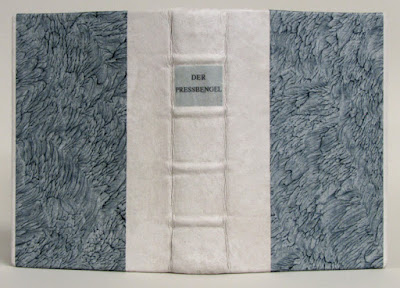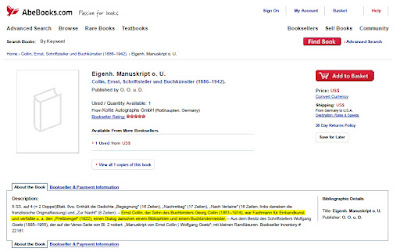Wie in den 4 vergangenen Jahren gebe ich am 31. Mai zu dem Geburtstag von Ernst Collin (dies wäre sein 130. gewesen) eine Jahreszusammenfassung von Funden und Fortschritten an meinem Projekt über die Collins. In diesem Jahr war recht viel los.
The Boss Dog Press Bone Folder
Boss Dog Press Pressbengel auf Englisch
Most significant is the starting of production for the Boss Dog Press' letterpress edition of Ernst Collin's The Bone Folder, illustrated with images depicting the binding process. Images were selected, and these are now being printed digitally at Light Work, a non-profit photography organization based at Syracuse University. For the edition, that means 8 images (6 "days"of dialog, a portrait of John (Hans) Schiff, and another image from the binding series for the prospectus) printed 120 times each... That's a lot of cutting. The edition will be available in a regular paper case, deluxe quarter leather, and sheets for binding. In addition to the photographs, the text features a new introduction correcting "errors" about Ernst Collin's identity and providing context for his original text in the form of an abbreviated history of the firm of W. Collin and his family. While we are still working out details, I can say that those pre-ordering the deluxe edition will also received a printed copy of the history and bibliography in English. As an aside, the blog header makes use of Don Rash's BDP FritzGotische hand-calligraphed type face, originally created for his Three Lectures, and used again in this fine press edition of the Bone Folder.
For more information about pre-ordering..., please contact the press at bossdogpress@donrashfinebookbinder.com.
Am bedeutendsten ist der Anfang von der Produktion des Pressendrucks meiner Übersetzung Ernst Collins Pressbengel von Don Rashs Boss Dog Press. Diese hat mit dem Druck der Aufnahmen von John (Hans) Schiff begonnen. Die Aufnahmen wurden digital geduckt bei Light Work, ein gemeinnütziger Verein für Photographie an der Syracuse University wo ich auch arbeite. Für die Auflage werden 8 Bilder (6 "Tage" Buchbinderei, ein Bild von Schiff, und eins fürs Prospekt) wurden 120 gedruckt. Das wird viel Schneiden bedeuten, wird aber Dank Vorplanung nicht so schlimm. Die Auflage wird es als Pappband, halb-leder Einband, und in Lagen zum Einbinden geben. Zusätzlich zu den Aufnahmen hat diese Ausgabe auch eine neue Einleitung die "Fehler" zum Leben Ernsts aus der ersten Auflage korrigiert, sowie eine gekürzte Geschichte der Familie und W. Collin. Details gibts noch viele durch zu arbeiten, aber Personen die die halb-leder Ausgabe im Voraus bestellen werden auch eine Druckexemplar der Geschichte und Bibliographie bekommen. Nebenbei, der Schriftzug im Header dieses Blogs ist Don Rash BDP FritzGotische, speziell von ihm für sein Buch Three Lectures per Hand geschaffen. Man wird sie wieder in dieser Ausgabe sehen.
Für mehr Information über Vorbestellungen..., melden Sie sich bitte bei der Presse, bossdogpress@donrashfinebookbinder.com.
| First look at proofs | Erste Ansicht der Druckproben |
| Annotations | Notierungen Printing can start | Das Ausdrucken kann beginnen |
| 42 Bone Folders | 42 Falzbeine For the prospectus | Für die Prospekte |
The Bone Folder in Japanese | Der Pressbengel auf Japanisch
Very satisfying was seeing Ernst's Pressbengel translated into Japanese based on my English translation as The Bone Folder. This work was done by Ms. Satoko Noro of the Nara-based "Laboratory for Preservation, Conservation, and Restoration," and published on their website in serialized form. The last installment appeared at the end of 2015. Wonderful to see this happen, and my thanks go out to them. The translation is illustrated with photographs of bookbinding tools and bindings. Below a screen-grab of the table of contents. A Google translation can be linked to here.
Sehr erfreulich war die Vollendung der japanischen Übersetzung vom Pressbengel anhand meiner englischen Übersetzung. Die Übersetzung von Frau Satoko Noro der "Laboratory for Preservation, Conservation, and Restoration"erschien in Folgen während 2015 und war mit Abbildungen von buchbinderischen Werkzeugen und Einbänden illustriert. s war wunderbar diese Übersetzung zu sehen und ich bin Frau Noro sehr dankbar. Unten ein Bild von dem Inhalt auf deren Webseite. Die Google Übersetzung gibts hier.
Just a short while I received a wonderful package from Ms. Noro, the translator. In it a bound tri-lingual copy of the Pressbengel – the original German, my English, her Japanese. A very special gift.
Vor einigen Tagen erhielt ich dann ein wundersames Päckchen von Frau Noro. Es sind der Ur-Pressbengel, mein Bone Folder, und Ihre Übersetzung in einem Band.
 |
| The binding | Der Einband |
 |
| The three title pages and colophon Die drei Titelseiten und das Kolophon |
The Collins: | Die Collins:
History and Bibliography | Geschichte und Bibliographie
Work on the history of W. Collin and bibliography of the writings of Ernst is in the final editing stages for English and German. The first part about W. Collin was released in German back in January as Eine Geschichte und Bibliographie der Berliner Hofbuchbinder und Schriftsteller, and was well received. One reader who found this first part online shared images of a W. Collin binding he had recently acquired, with an image to be included in the final version. I've also shared other images... under the W. Collin tag, all of which are included in the history/bibliography that is pending. In the mean time the bibliographical listing of all of Ernst's writings found to date is available here, including in a spreadsheet with links via HathiTrust and other sources. Just click the navigation bar at top.
Arbeit an der Geschichte von W. Collin und der Bibliographie der Schriften von Ernst nähert sich dem Ziel auf Englisch und Deutsch. Das erste Teil über W. Collin auf Deutsch wurde im Januar als Eine Geschichte und Bibliographie der Berliner Hofbuchbinder und Schriftsteller geteilt mit guter Rezonance. Ein Leser der dieses Teil teilte sogar Bilder von einem W. Collin Einband den er erworben hat. Eine Aufnahme davon wir mit seiner Erlaubnis in der Geschichte gezeigt. Ich habe auch andere arbeiten unter dem "Tag" W. Collin geteilt die auch in der Geschichte erscheinen werden. In der Zwischenzeit ist die bibliographische Aufzeichnung von Ernst Collins schriften einsehbar mit Link zu einer Tabele die zu digitalisierten Versionen bei HathiTrust von vielen der Schriften Führt. Einfach oben auf den Link klicken...
 |
| Tentative cover design for the English version of history and bibliography Vorläufiger Umschlag für die englische Fassung der Geschichte und Bibliographie |
The base image for the cover above is drawn from Baedeker's Northern Germany as far as the Bavarian and Austrian frontiers; handbook for travellers (11th ed., 1893). In this example from the 1910 edition, the foldout map was unfortunately not unfolded during digitization (A common lament with Google Books content), but could be found from the University of Texas. The map shows almost all streets where the firm of W. Collin was located. Overlaid images show selections of the work of W. Collin and writings of Ernst, all described in the text.
Als Unterlage dient dieser Plan der Stadtmitte Berlins aus Baedekers Northern Germany as far as the Bavarian and Austrian frontiers; handbook for travellers (11. Ausgabe, 1893). Wie allgegenwärtig bei Goggle Books wurde der plan nicht entfaltet, aber ein Exemplar der Auflage von 1910 ist bei der University of Texas zu finden. Auf dem Plan sind fast alle Standorte von W. Collin zu finden, wenigstens den Strassen nach. Dazu dann Beispiele von Arbeiten W. Collins und Schriften von Ernst.
This text will be available online in English and German by the end of June, 2016.
Der Text wird bis Ende Juni 2016 auf Englisch und Deutsch online erscheinen.
Other news | Weitere Nachrichten
In lieu of a photo of Ernst Collin, I was very pleased to find a copy of the semi-deluxe edition of his Paul Kersten, signed by him and Kersten. The signature provides a nice direct connection to his work.
Ich suche immer noch vergebens nach einem Bild von Ernst Collin, war aber sehr froh ein Exemplar der fast luxus-Auflage von Paul Kersten mit Unterschrift von Kersten und Ernst zu bekommen. Eine schöne direkte Verbindung zu letzerem.
 |
| Colophon from Paul Kersten | Kolophon von Paul Kersten |
I was also able to find copy of one of the later editions of Ernst's Buchbinderei für den Hausbedarf, perhaps the first manual in German written for amateurs. This stands in contrast to England where numerous manuals for amateurs and school children were written. I especially like the new cover design depicting a woman doing the binding in her well-equipped home workshop. Women in bookbinding was a topic that the Collins were active in supporting.
Im letzten Jahr konnte ich auch ein Exemplar von einer der spãteren Auflagen von Ernsts Buchbinderei für den Hausbedarf finden. Dies ist vielleicht die erste Anleitung in die Buchbinderei für Amateure in deutscher Sprache. Dies ist im Kontrast zu England wo es mehrere solche Bücher gab für Amateure und Schulkinder. Der Umschlag gefällt mir besonders, war doch die Rolle der Frau in der Buchbinderei ein Anliegen der Collins.
Another acquisition was a postcard of Kaffee Klose at Leipzigerstrasse 19. W. Collin had a "storefront" upstairs, and the lettering on the window can even be read. Another nice direct connection.
Noch ein Ankauf war diese Postkarte von Kaffe Klose in der Leipzigerstrasse 19 im 3. Stock ein "Schaufenster." In der Postkarte kann man sogar die Fenstermalerei erkennen. Wieder eine schöne Verbindung.
 |
| Click to enlarge |
The "other" Ernst | Der "andere" Ernst
In my "quest" to disambiguate the two Ernsts, I purchased a small grouping of poems by Ernst Collin-Schönfeld last summer that were attributed to Ernst Collin in the dealer listing. I had seen the listing for some time, written to the dealer to ask him to attribute to the proper Ernst with no response, so finally just bought them...Nice to have in the set, really just a signature removed from a notebook as evidenced by the grid pattern on the paper, was the poem "Zur Nacht." The papers of Ernst Collin-Schönfeld at the Leo Baeck Institute hold a typescript of the poem providing a crucial linkage.
Weil ich auch weiterhin bemüht bin die beiden Ernste zu trennen, habe ich im letzten Sommer eine kleine lage Gedichte von Ernst Collin-Schönfeld aus einem Notizbuch gekauft. Ich hatte dieses Manuskript schon einige Male gesehen, den Antiquar auf die zwei Ernst aufmerksam gemacht ohne erfolg, und es letzten Endes einfach gekauft... Dabei war das Gedicht "Zur Nacht." In dem Archiv von Ernst Collin-Schönfeld beim Leo Baeck Institut ist auch eine Druckschrift des Gedichts was auch als "Beweis" der Verbindung mit dem "anderen" Ernst dient.
 |
| Click here to see typescript of the poem at the Leo Baeck |
I had written to the curator of the Leo Baeck offering these manuscripts as a gift, but never received a response. That offer still stands...
Ich hatte den Archivar des Leo Baeck angeschrieben und diese Manuskripte als Geschenk angeboten. Habe aber nie eine Antwort bekommen. Das Angebot steht noch, bitte melden...









